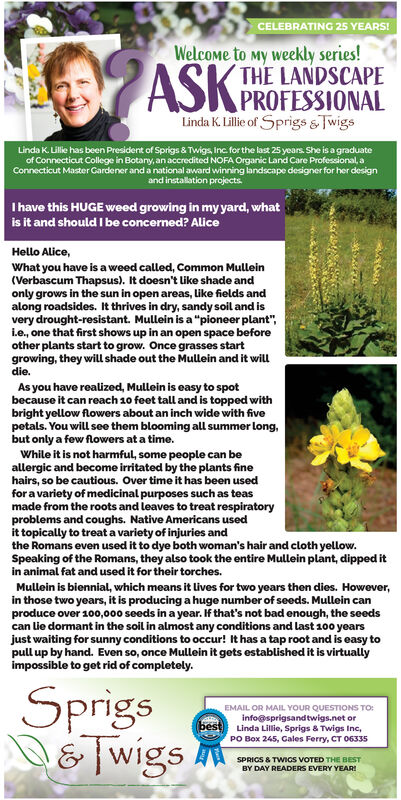Advertisement

-
Published Date
August 22, 2021This ad was originally published on this date and may contain an offer that is no longer valid. To learn more about this business and its most recent offers, click here.
Ad Text
CELEBRATING 25 YEARS! Welcome to my weekly series! THE LANDSCAPE ASKPROFESSIONAL Linda K. Lillie of Sprigs & Twigs Linda K. Lillie has been President of Sprigs & Twigs Inc. for the last 25 years. She is a graduate of Connecticut College in Botany, an accredited NOFA Organic Land Care Professional, a Connecticut Master Gardener and a national award winning landscape designer for her design and installation projects. I have this HUGE weed growing in my yard, what is it and should I be concerned? Alice Hello Alice, What you have is a weed called, Common Mullein (Verbascum Thapsus). It doesn't like shade and only grows in the sun in open areas, like fields and along roadsides. It thrives in dry, sandy soil and is very drought-resistant. Mullein is a "pioneer plant", i.e., one that first shows up in an open space before other plants start to grow. Once grasses start growing, they will shade out the Mullein and it will die. As you have realized, Mullein is easy to spot because it can reach 10 feet tall and is topped with bright yellow flowers about an inch wide with five petals. You will see them blooming all summer long, but only a few flowers at a time. While it is not harmful, some people can be allergic and become irritated by the plants fine hairs, so be cautious. Over time it has been used for a variety of medicinal purposes such as teas made from the roots and leaves to treat respiratory problems and coughs. Native Americans used it topically to treat a variety of injuries and the Romans even used it to dye both woman's hair and cloth yellow. Speaking of the Romans, they also took the entire Mullein plant, dipped it in animal fat and used it for their torches. Mullein is biennial, which means it lives for two years then dies. However, in those two years, it is producing a huge number of seeds. Mullein can produce over 100,000 seeds in a year. If that's not bad enough, the seeds can lie dormant in the soil in almost any conditions and last 100 years just waiting for sunny conditions to occur! It has a tap root and is easy to pull up by hand. Even so, once Mullein it gets established it is virtually impossible to get rid of completely. Sprigs DETwigs EMAIL OR MAIL YOUR QUESTIONS To: info@sprigsandtwigs.net or Linda Lillie, Sprigs & Twigs Inc, PO Box 245, Gales Ferry, CT 06335 SPRICS & TWIGS VOTED THE BEST BY DAY READERS EVERY YEAR! CELEBRATING 25 YEARS! Welcome to my weekly series! THE LANDSCAPE ASKPROFESSIONAL Linda K. Lillie of Sprigs & Twigs Linda K. Lillie has been President of Sprigs & Twigs Inc. for the last 25 years. She is a graduate of Connecticut College in Botany, an accredited NOFA Organic Land Care Professional, a Connecticut Master Gardener and a national award winning landscape designer for her design and installation projects. I have this HUGE weed growing in my yard, what is it and should I be concerned? Alice Hello Alice, What you have is a weed called, Common Mullein (Verbascum Thapsus). It doesn't like shade and only grows in the sun in open areas, like fields and along roadsides. It thrives in dry, sandy soil and is very drought-resistant. Mullein is a "pioneer plant", i.e., one that first shows up in an open space before other plants start to grow. Once grasses start growing, they will shade out the Mullein and it will die. As you have realized, Mullein is easy to spot because it can reach 10 feet tall and is topped with bright yellow flowers about an inch wide with five petals. You will see them blooming all summer long, but only a few flowers at a time. While it is not harmful, some people can be allergic and become irritated by the plants fine hairs, so be cautious. Over time it has been used for a variety of medicinal purposes such as teas made from the roots and leaves to treat respiratory problems and coughs. Native Americans used it topically to treat a variety of injuries and the Romans even used it to dye both woman's hair and cloth yellow. Speaking of the Romans, they also took the entire Mullein plant, dipped it in animal fat and used it for their torches. Mullein is biennial, which means it lives for two years then dies. However, in those two years, it is producing a huge number of seeds. Mullein can produce over 100,000 seeds in a year. If that's not bad enough, the seeds can lie dormant in the soil in almost any conditions and last 100 years just waiting for sunny conditions to occur! It has a tap root and is easy to pull up by hand. Even so, once Mullein it gets established it is virtually impossible to get rid of completely. Sprigs DETwigs EMAIL OR MAIL YOUR QUESTIONS To: info@sprigsandtwigs.net or Linda Lillie, Sprigs & Twigs Inc, PO Box 245, Gales Ferry, CT 06335 SPRICS & TWIGS VOTED THE BEST BY DAY READERS EVERY YEAR!
